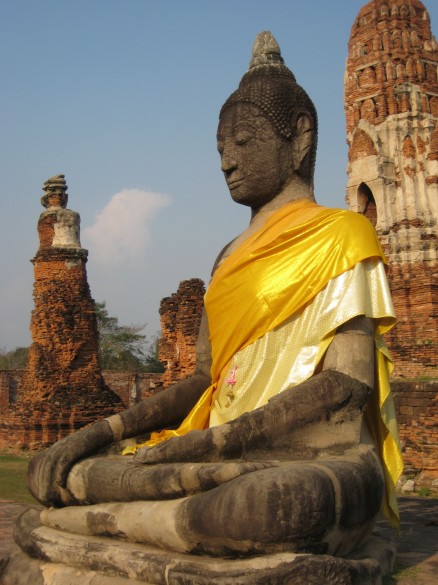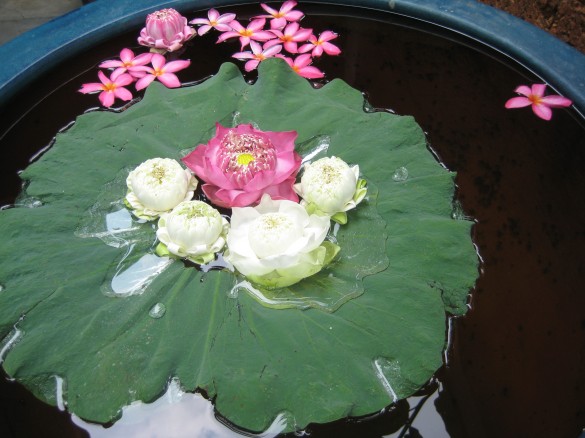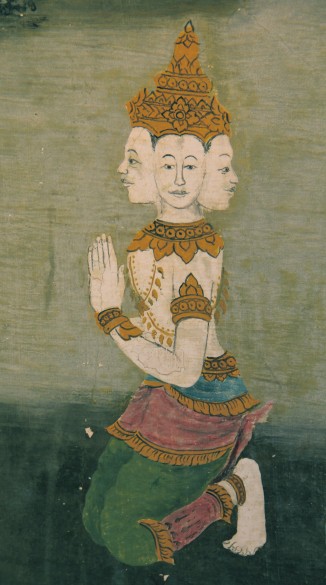To the casual visitor, Thailand is a tropical dream – all coconut shakes, pad thai and palm trees. The service is generally good, people seem friendly and English is widely spoken. Thailand for many is just enough Asia to be exotic while still being familiar enough to be safe and fun.
Dig a little deeper however and you being to see that though Thai culture seems mostly westernized, this is a mirage. Thai culture, like their fragrant cuisine is both subtle and strong. One of the most important and visible aspects is the ubiquitous wai or bow. Everyone form shopkeepers to Ronald McDonald is doing it.
What may seem to travelers to be a simple bow is in fact a deep and complex tradition whose use can gain you local respect or make you look like a complete farang.

The wai has common origins with similar gestures made in Cambodia and India. It is Indic in origin and spread to Thailand along with Buddhism and Hinduism centuries ago. A very similar gesture is used still in Cambodia as well as other parts of Southeast Asia. Most commonly it is used to convey gratitude or respect.
To start with the wai is made with the hands placed together in prayer like formation; the palms should not touch but curve outward very slightly. This is to mimic the appearance of a lotus bud, which is a scared metaphor for the inner Buddha rising above the suffering of the world. The arms should be help out from the body, forearms parallel to the ground
There are five kinds of wai for five different levels of social interaction. Thai culture is very conscious of social standing and had a much more rigid hierarchy than in the west. Wai-ing is a recognition of that social difference, or similarity.
The first wai is the Royal Wai, it is used for the king. The chances of you using it are extremely low, but its good to know so you don’t do it accidentally to somebody else. To make this wai place your lotus bud palms together almost above your head. Your thumbs should touch he top of your head. This is accompanied by a very deep bow.
The second wai is the Holy Wai and it is used for praying to images of the Buddha in temples or for wai-ing to monks. If you visit any of the main tourist sights in Bangkok or beyond you will probably find yourself in proximity to both of these things. To make this wai place your lotus bud palms at the level of your forehead. The tips of your thumbs should touch your hairline, and this should be accompanied by a bow. If you wai to a monk the bow should be deep, if you are seated in a temple bowing to the Buddha your forehead should touch the floor
It may come as a surprise to many that the King’s wai is a higher level than the wai for the Buddha or monks but the King in Thailand is highly revered and even his image is given the utmost respect.

The third wai is the Elder Wai it is used to convey respect to people older than you and those who are above you in social status. To make this wai place your lotus bud palm around the area of your face, your thumbs should touch the tip of your nose. There is a small bow here, more of a tilt. (Unless it’s to a cop and you’re at a full moon with something you shouldn’t have, then I would bow a bit more.) You can generally tell how severe the difference between two individuals is by the depth of bow, the deeper the bow the more respect.
This is when things get tricky. Without inside knowledge it is hard to determine who is above you in social rank. Do you elder wai an elderly street sweeper? Do you give this wai to a young person in the business elite when you are a backpacker? Technically the answer is no and yes respectively. Thai notions of higher and lower may be different than yours.
The fourth wai is the Equals Wai and it is used for people of the same status as you. If you are an English teacher this is the wai you use for your colleges. This is made at a slightly lower level than the elder wai with your lotus bud palms around your mouth, your thumbs should be places under your chin and your index finger should be at your nose. There is no bow here, just an inclination of the head.
The fifth wai is the last level of wai, it is the Response Wai and it is used to respond to the wais of people who are younger or lower in social status than you. If children wai you (unless they are monks) this is the appropriate wai. To make this wai place your lotus bud hands at the level of your heart and do not bow.

Because it can be difficult to understand where on the social pecking order you lie it is a good idea when you are starting out to wait for other people to wai you. If they wai with an “Equals Wai” than you should respond with an “Equals Wai”. If somebody wais you with an “Elder Wai” you should respond with a “Response Wai”.
It can be difficult for many people to become comfortable with recognizing social difference, especially if you are from a culture that tries to view everyone as equal. It should be said that giving the wrong wai, whether too high or too low, is seen as very insulting. It is a loss of face for both you and the recipient of the wai. So don’t try to make a beggar feel better, for example, by giving an “Elder Wai”. At the least you will look foolish but your risk offending some people.
If you don’t feel comfortable with the practice, don’t wai. It’s perfectly ok not to wai, as a foreigner it isn’t expected. However learning the local culture will go a long way with improving your repertoire with Thais and if you are planning on making Thailand a semi-permanent home than it is a good idea to become familiar with the this important gesture.